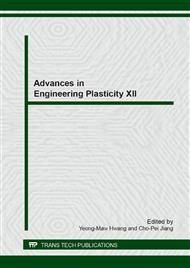[1]
C.Z. Duan, L.C. Zhang, Adiabatic shear banding in AISI 1045 steel during high speed machining: Mechanisms of microstructural evolution, Mater Sci Eng A. 532 (2012) 111-119.
DOI: 10.1016/j.msea.2011.10.071
Google Scholar
[2]
C.Z. Duan, L.C. Zhang, H.Y. Yu, M.J. Wang, An investigation into the microstructure of adiabatic shear banding in AISI 1045 hardened steel due to high speed machining, Advanced Materials Research. 154-155 (2011) 321-324.
DOI: 10.4028/www.scientific.net/amr.154-155.321
Google Scholar
[3]
G. Johnson, W. Cook, Fracture characteristics of three metals subjected to various strains, strain rates, temperatures and pressures, Eng Fract Mech. 21 (1985) 31–48.
DOI: 10.1016/0013-7944(85)90052-9
Google Scholar
[4]
W. Lee, C. Lin, High-temperature deformation behavior of Ti6Al4V alloy evaluated by high strain-rate compression tests, J Mater Process Tech. 75 (1998) 127-136.
DOI: 10.1016/s0924-0136(97)00302-6
Google Scholar
[5]
H. Meyer, D. Kleponis, Modeling the high strain rate behavior of titanium undergoing ballistic impact and penetration, Int J Impact Eng. 26 (2001) 509-521.
DOI: 10.1016/s0734-743x(01)00107-5
Google Scholar
[6]
G. Kay, Failure modeling of titanium Ti-6Al-4V and aluminum 2024-T3 with the Johnson–Cook material model. Report of U.S. Lawrence Livermore National Lab, DOT/FAA/AR-03/57 (2003)
DOI: 10.2172/15006359
Google Scholar
[7]
S. Seo, O. Min, H. Yang, Constitutive equation for Ti-6Al-4 V at high temperatures measured using the SHPB technique, Int J Impact Eng. 31 (2005) 735-754.
DOI: 10.1016/j.ijimpeng.2004.04.010
Google Scholar
[8]
Z. Cao, et al., Chip formation and its numerical simulation in high speed cutting of Ti6Al4V alloy, China Mech Eng. 19 (2008) 2450-2454.
Google Scholar
[9]
D. Umbrello, Finite element simulation of conventional and high speed machining of Ti6Al4V alloy, J Mater Process Tech. 196 (2008) 79–87.
DOI: 10.1016/j.jmatprotec.2007.05.007
Google Scholar
[10]
C.Y. Gao, L.C. Zhang, A constitutive model for dynamic plasticity of FCC metals, Mater Sci Eng A. 527 (2010) 3138–3143.
DOI: 10.1016/j.msea.2010.01.083
Google Scholar
[11]
C.Y. Gao, et al., A constitutive description of the thermo-viscoplastic behaviour of body-centered cubic metals, Mater Design. 36 (2012) 671–678.
DOI: 10.1016/j.matdes.2011.12.012
Google Scholar
[12]
C.Y. Gao, L.C. Zhang, H. Yan, A new constitutive model for HCP metals, Mater Sci Eng A. 528 (2011) 4445–4452.
DOI: 10.1016/j.msea.2011.02.053
Google Scholar
[13]
C.Y. Gao, L.C. Zhang, Constitutive modeling of plasticity of fcc metals under extremely high strain rates, Int J Plasticity. 32-33 (2012) 121–133.
DOI: 10.1016/j.ijplas.2011.12.001
Google Scholar
[14]
G. Cowper, P. Symonds, Strain hardening and strain rate effects in the impact loading of cantilever beams, Brown Univ, Div Appl Mech, Report no. 28. (1952)
DOI: 10.21236/ad0144762
Google Scholar
[15]
U. Andrade, et al., Dynamic recrystallization in high-strain, high-strain-rate plastic deformation of copper, Acta Metall et Mater. 42 (1994) 3183–3195.
DOI: 10.1016/0956-7151(94)90417-0
Google Scholar
[16]
H. Zhang, W. Wen, H. Cui, Behaviors of IC10 alloy over a wide range of strain rates and temperatures: experiments and modeling steel, Mater Sci Eng A. 504 (2009) 99–103.
DOI: 10.1016/j.msea.2008.10.056
Google Scholar
[17]
M. Vural, J. Caro, Experimental analysis and constitutive modeling for the newly developed 2139-T8 alloy, Mater Sci Eng A. 520 (2009) 56–65.
DOI: 10.1016/j.msea.2009.05.026
Google Scholar
[18]
A. Khan, R. Liang, Behavior of three BCC metal over a wide range of strain rates and temperatures. Int J Plasticity. 15 (1999) 1089–1109.
DOI: 10.1016/s0749-6419(99)00030-3
Google Scholar
[19]
M. Sima, T. Ozel, Modified material constitutive models for serrated chip formation simulations and experimental validation in machining of titanium alloy Ti6Al4V, Int J Machine Tools & Manuf. (2010) 943–960.
DOI: 10.1016/j.ijmachtools.2010.08.004
Google Scholar
[20]
Y. Karpat, Temperature dependent flow softening of titanium alloy Ti6Al4V: An investigation using finite element simulation of machining, J Mater Process Tech. 211 (2011) 737–749.
DOI: 10.1016/j.jmatprotec.2010.12.008
Google Scholar
[21]
P. Zerilli, R. Armstrong, Dislocation mechanics based constitutive relations for material dynamics calculations, J Appl Phys. 61 (1987) 1816–1825
DOI: 10.1063/1.338024
Google Scholar
[22]
C.Y. Gao, L.C. Zhang, P.H. Liu, Y.L. Ke, On the role of material model in the finite element simulation of high speed machining of Ti6Al4V, submitted to Science China Technological Sciences (2014).
Google Scholar
[23]
L.C. Zhang, On the separation criteria in the simulation of orthogonal metal cutting using the finite element method, J Mater Process Tech. 89-90 (1999) 273-278.
DOI: 10.1016/s0924-0136(99)00023-0
Google Scholar
[24]
L.C. Zhang, Solid Mechanics for Engineers, Palgrave/Macmillan, New York (2001).
Google Scholar


